
This large ant seems to be some kind of queen or an unlikely a wondering male. I really have no idea what it is yet. Some kind of carpenter ant would be my best guess. It was about 15mm long! I was able to get a number of shots of it with my backup camera including this one.
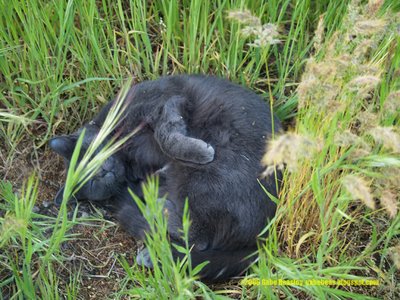 Ever wonder what your cat does all day?
Ever wonder what your cat does all day?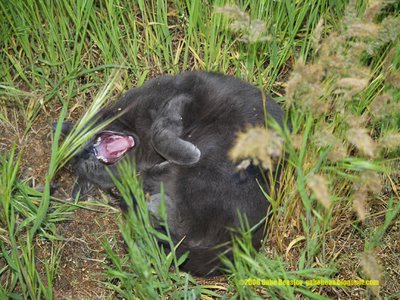 And then the yawn. And it's back to sleep, this time with a paw over his eye as if to say “..get out of here and let me sleep!”.
And then the yawn. And it's back to sleep, this time with a paw over his eye as if to say “..get out of here and let me sleep!”.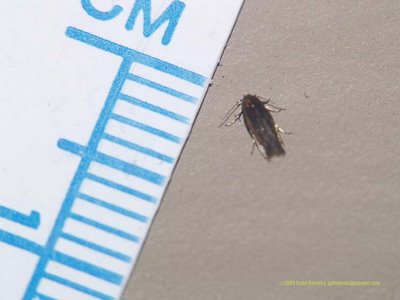 As you can see this is a VERY SMALL insect. It is a moth, the smallest I have ever found. Nearly hard to see and impossible to tell with the naked eye what kind of insect it is--with my macro lens I found out. This tiny moth measuring only about 3mm long is shown here un-cropped. So I can and WILL bring you a blown-up crop of this moth later. It is about the third smallest arthropod I have ever photographed.
As you can see this is a VERY SMALL insect. It is a moth, the smallest I have ever found. Nearly hard to see and impossible to tell with the naked eye what kind of insect it is--with my macro lens I found out. This tiny moth measuring only about 3mm long is shown here un-cropped. So I can and WILL bring you a blown-up crop of this moth later. It is about the third smallest arthropod I have ever photographed.
Iridescent green-gold bees came again this summer. I got hit with a warning from The Dalles about my yard! My weeds I let grow in the back yard towards an ally became too much. Dandy lions are very good flowers to attract all kinds of insects.
THE "UN-KNOWN" TOXINS--A VIEW ABOUT USE OF HERBSIDES AND INSECTERSIDES--JUST HOW DANGEROUS ARE THEY?
>I have been told about weed and bug killers. My personal bias aside, I have an OUTCRY TO THE PEOPLE about the dangers of toxic poisons used to kill weeds, insects and CROP HERBISDES. THESE CHEMICALS ARE SOMETIMES NEW AND HAVE NEVER BEEN TESTED. PEOPLE ARE GETTING CANCER AT AN INCREDIBLY ALARMING RATE. A CHEMICAL THAT CAN DO SO WELL AT KILLING ONE TYPE OF ANIMAL OR PLANT IS VERY TOXIC. Like DDT was banned after killing countless birds and other animals--we really have no idea what the long term effect on us many new insecticides and other chemicals will have on us. If we can't even figure out how dangerous some new prescription drugs that are quickly found to be tragically dangerous; how could we possibly think that non-consumable toxins manufactured under far less restricted terms could be?
READ MORE UNDER "THE STORY" under "TOXINS"

Don't ask me what kind of flower these are, but they are very common where ever they have a chance to grow around here in The Dalles. I have at least 40 pictures of these flowers which range in color but clearly trans tans-pollinated creating many color blends.
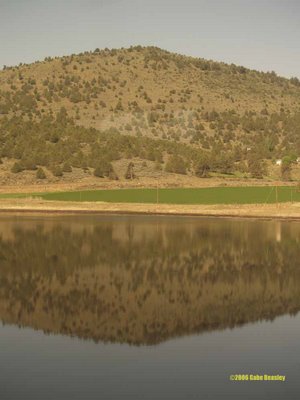 A shot I took on my trip to California. Now that I will be doing this about every month, I am going to be getting allot of rare-opportunities for pictures. I only hope I will be able to fix my camera. Repair costs might be difficult. I tell people ALLWAYS keep a backup. Keep your old camera and lenses--don't give them away and be completely without a camera! That would be really bad. A well-built 4 mega-pixel camera is comparable to high-def 35mm film. Some say 5 is more like it, but my tests and what I have seen have me convinced that a good 4MP camera is all you need. My backup is a 6.1 and I have a teli-photo, teli-macro, and wide angle lenses for it. I kept it and kept it ready for emergencies like the one I have now.
A shot I took on my trip to California. Now that I will be doing this about every month, I am going to be getting allot of rare-opportunities for pictures. I only hope I will be able to fix my camera. Repair costs might be difficult. I tell people ALLWAYS keep a backup. Keep your old camera and lenses--don't give them away and be completely without a camera! That would be really bad. A well-built 4 mega-pixel camera is comparable to high-def 35mm film. Some say 5 is more like it, but my tests and what I have seen have me convinced that a good 4MP camera is all you need. My backup is a 6.1 and I have a teli-photo, teli-macro, and wide angle lenses for it. I kept it and kept it ready for emergencies like the one I have now.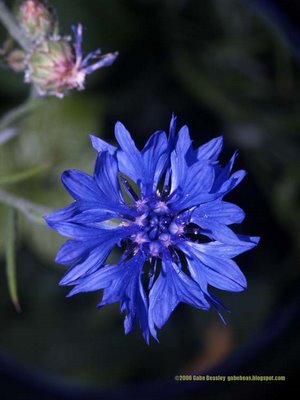 Yet another one of these wildflowers. There can be allot of them growing from one bush.
Yet another one of these wildflowers. There can be allot of them growing from one bush.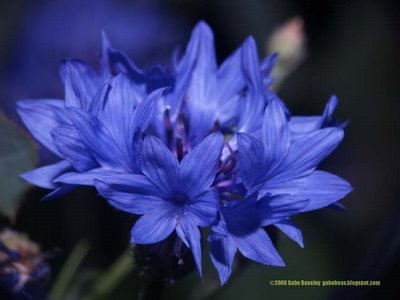 This has been a great time. I lost that area to take pictures in when they bulldozed it completely to dust. Literally! I thought nothing would grow back but I was very surprised and since the briars had not taken over yet (they kill every other kind of diverse plant)--I got many chances to take pictures of wildflowers and plants in this lot when it quickly grew back.
This has been a great time. I lost that area to take pictures in when they bulldozed it completely to dust. Literally! I thought nothing would grow back but I was very surprised and since the briars had not taken over yet (they kill every other kind of diverse plant)--I got many chances to take pictures of wildflowers and plants in this lot when it quickly grew back. Many colors and bushes compete for space. Flies and bees come to these flowers but you have to be really careful. I always ware long pants out there--even with them thorns and stuff can be difficult.
Many colors and bushes compete for space. Flies and bees come to these flowers but you have to be really careful. I always ware long pants out there--even with them thorns and stuff can be difficult. I dive right in and started taking pictures with an old Nikon higher-powered flash mounted on my digital SLR. It provides at least 5X more light then the internal flash but the internal flash is surprisingly effective when used right.
I dive right in and started taking pictures with an old Nikon higher-powered flash mounted on my digital SLR. It provides at least 5X more light then the internal flash but the internal flash is surprisingly effective when used right.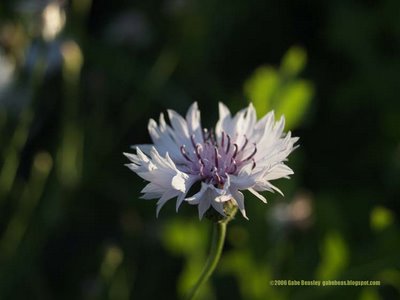 And for the best shots sometimes no flash is needed. Lighting can turn out well. I did break a bit of photographic rules here but I was in a patch of weeds and afraid somebody would get the wrong idea about what I was doing there so framing my shots was not exactly as well thought out as usual!
And for the best shots sometimes no flash is needed. Lighting can turn out well. I did break a bit of photographic rules here but I was in a patch of weeds and afraid somebody would get the wrong idea about what I was doing there so framing my shots was not exactly as well thought out as usual!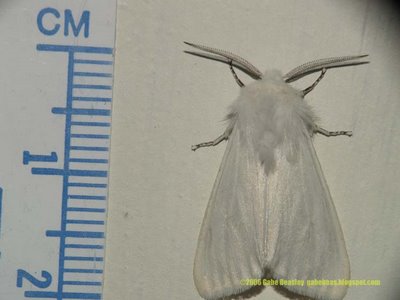 I have not looked up this one of MANY moths here. All white. Incredible. The ruler on the side is measured in CM. But each individual line to line is 1mm. I have decided to use this scale more often to show how small these subjects are. This moth was not that small--about exactly as you can see 2cm with wings. (20mm long 18mm body only)
I have not looked up this one of MANY moths here. All white. Incredible. The ruler on the side is measured in CM. But each individual line to line is 1mm. I have decided to use this scale more often to show how small these subjects are. This moth was not that small--about exactly as you can see 2cm with wings. (20mm long 18mm body only)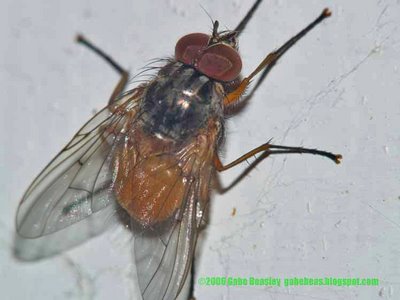 As near as I can tell, this is some kind of nocturnal specialized fly. Notice the very large eyes when compared to regular flies shot during the daytime. Now those kinds of flies do often land when it gets to cold and stuff near lights--but in this case the color of it's abdomen and the size and shape of there eyes leads me to think that they are probably a nocturnal species or require more visual ability for some reason. I really don't know yet and I have not yet identified this one or tried very hard--but I've got quite a few shots of them. At high-res they are really cool.
As near as I can tell, this is some kind of nocturnal specialized fly. Notice the very large eyes when compared to regular flies shot during the daytime. Now those kinds of flies do often land when it gets to cold and stuff near lights--but in this case the color of it's abdomen and the size and shape of there eyes leads me to think that they are probably a nocturnal species or require more visual ability for some reason. I really don't know yet and I have not yet identified this one or tried very hard--but I've got quite a few shots of them. At high-res they are really cool.Buy a CD and check it out---$20 bucks--!--e-mail me!
 There are many kinds of wildflowers here. I plan to post more of them and try to maintain this site as more then just a site for bugs. I also have a very large number of landscapes and have began working on people pictures and portraits. The flowers I hope will take the bite off the spiders in my website.
There are many kinds of wildflowers here. I plan to post more of them and try to maintain this site as more then just a site for bugs. I also have a very large number of landscapes and have began working on people pictures and portraits. The flowers I hope will take the bite off the spiders in my website.In the mirror and with friends I've began to learn how the lighting works and other subtle details needed to take a really good portrait. External flashes and or flashguns are a must. If your really on a budget you can build your own reflectors out of aluminum foil and use an inexpensive flash that has a fire-button on it. Many of them do even if they are built to mount on cameras. The lighting is very important but this, like all of photography is a very complex process of learning. I have much to learn!
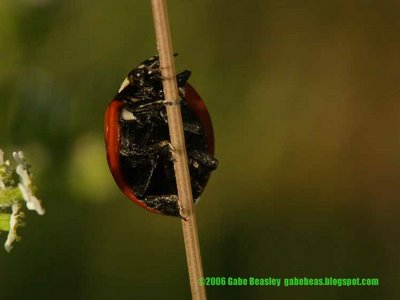 Ladybugs can be interesting to watch. They are difficult to photograph in the wild but all my shots are either to my bug lights or the wild. I don't recall ever having "setup" a shot like putting a cold bug on a limb or something. I am proud of my knowledge of insects and photography which lets me get these kinds of shots in the field--no cooling and no posing. At these macro levels I shoot at f22 and be very careful since literally 1mm off and you lose the shot. You can't drink coffee and take pictures like this! When I get old and shaky I bet cameras will be far more advanced and a simple monopod can make these shots more possible if you are a bit shaky.
Ladybugs can be interesting to watch. They are difficult to photograph in the wild but all my shots are either to my bug lights or the wild. I don't recall ever having "setup" a shot like putting a cold bug on a limb or something. I am proud of my knowledge of insects and photography which lets me get these kinds of shots in the field--no cooling and no posing. At these macro levels I shoot at f22 and be very careful since literally 1mm off and you lose the shot. You can't drink coffee and take pictures like this! When I get old and shaky I bet cameras will be far more advanced and a simple monopod can make these shots more possible if you are a bit shaky.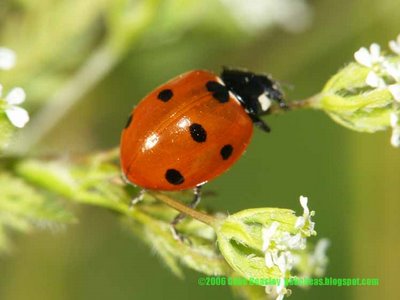 I'm still not clear on why ladybugs have different numbers of spots and sizes. I have allot of research to do a pictures to add to this site. My backlog is literally 1000s of pictures old. So even if it takes me 4 months to fix my camera. My backup is powerful enough that I may use it in the meantime. . It's probably some kind of sensor or electric connection problem. The Dalles is very though on electrical connections. And there are thousands and thousands of tiny connections that make very complex cameras work. It's incredible they work at all. When I got angry I thought of the Hurricane victims--and what it would be like to have nothing left. You don't have to look to far to find someone who has it worse then you, my grandma used to say. I will get it fixed, and even if I have to buy a new camera body--it would take time but it’s not like I lost my whole rig.
I'm still not clear on why ladybugs have different numbers of spots and sizes. I have allot of research to do a pictures to add to this site. My backlog is literally 1000s of pictures old. So even if it takes me 4 months to fix my camera. My backup is powerful enough that I may use it in the meantime. . It's probably some kind of sensor or electric connection problem. The Dalles is very though on electrical connections. And there are thousands and thousands of tiny connections that make very complex cameras work. It's incredible they work at all. When I got angry I thought of the Hurricane victims--and what it would be like to have nothing left. You don't have to look to far to find someone who has it worse then you, my grandma used to say. I will get it fixed, and even if I have to buy a new camera body--it would take time but it’s not like I lost my whole rig.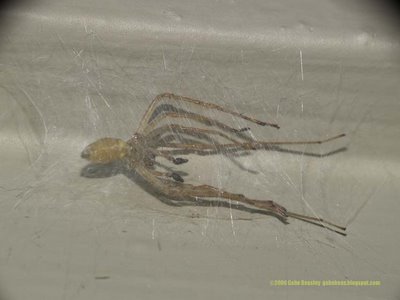 WHAT IS WRONG WITH THIS SPIDER! Well, nothing. This male Sack spider is in the process of shedding his skin. Like snakes, spiders must shed there skins every few months or weeks in order to grow. This is the most difficult time for the spider as it is entirely helpless when it has to be in this position to shed. You can see a bit of the sack-like cocoon they build both for protective hiding and shelter. I have the power to run time-laps with my digital camera and one of my very old video cameras. But setting it up is complex and difficult and I was too tired that night. It won't take him long--but he's got to shed. When he's done there will be a neat peace of skin laying next to him. These are often mistaken as another dead spider. eaten or dead, whatever. NOT TRUE. As most people have seen these ghostly shells in webs if they have observed spiders for any amount of time. The quickest way to tell if it's a dead spider or shedding is that they are usually very transparent and nearly complete, not broken up in many peaces. They last for years and can be seen often in attacks or outside by lights where spiders live. They hunt by walking with very good tactile sensory hairs which can sense motion. They are very fast and only move when they need too Inside there sacks they will bite if molested by an insect or another species of spider. Biting through the sack gives the spider some protection further then they would have if alone as the attacker cannot get inside very quickly or well in most cases. Do not touch these sacks, although sack spiders are not considered dangerous--any spider bite will have it’s effects and like a drug you do not know if you are allergic. It’s just best not to work bare handed and take risks of being bit when you do not have to.
WHAT IS WRONG WITH THIS SPIDER! Well, nothing. This male Sack spider is in the process of shedding his skin. Like snakes, spiders must shed there skins every few months or weeks in order to grow. This is the most difficult time for the spider as it is entirely helpless when it has to be in this position to shed. You can see a bit of the sack-like cocoon they build both for protective hiding and shelter. I have the power to run time-laps with my digital camera and one of my very old video cameras. But setting it up is complex and difficult and I was too tired that night. It won't take him long--but he's got to shed. When he's done there will be a neat peace of skin laying next to him. These are often mistaken as another dead spider. eaten or dead, whatever. NOT TRUE. As most people have seen these ghostly shells in webs if they have observed spiders for any amount of time. The quickest way to tell if it's a dead spider or shedding is that they are usually very transparent and nearly complete, not broken up in many peaces. They last for years and can be seen often in attacks or outside by lights where spiders live. They hunt by walking with very good tactile sensory hairs which can sense motion. They are very fast and only move when they need too Inside there sacks they will bite if molested by an insect or another species of spider. Biting through the sack gives the spider some protection further then they would have if alone as the attacker cannot get inside very quickly or well in most cases. Do not touch these sacks, although sack spiders are not considered dangerous--any spider bite will have it’s effects and like a drug you do not know if you are allergic. It’s just best not to work bare handed and take risks of being bit when you do not have to. Long exposure creations made with my face and a spy camera right out of a James Bond movie. This is one of my recent experiments with light reflections and exposures that become distorted due to shutter changes. These are just a few of the strange images I have been playing with. I have some incredible optical illusions I have created which have given me insight into just how some magicians do there tricks. Optics can play a serious trick that is easy to believe as impossible. The reflection shots I will post probably post later.
Long exposure creations made with my face and a spy camera right out of a James Bond movie. This is one of my recent experiments with light reflections and exposures that become distorted due to shutter changes. These are just a few of the strange images I have been playing with. I have some incredible optical illusions I have created which have given me insight into just how some magicians do there tricks. Optics can play a serious trick that is easy to believe as impossible. The reflection shots I will post probably post later. These pictures were taken with a mini-video camera straight out of a movie. A simple and pretty good quality video camera this size of a pack of cigarettes which has a flip screen and can record constant images on SD cards for up to several hours, record audio only compressed, play MP3s and can take still images to about 1.5mp. It can take SD cards up to 2GB. I use a 512 when I played with this cool toy so I could fit it's contents all on one CD. It's got simple controls and lots of power. Sometimes to use a camera with very limited manual functions you find something that is unexpected in the art of it. This shot could have been set up with any of my more powerful cameras--but it was far easier with the 1mp full-auto only camera. The settings on this camera like most can be frozen (like EV settings on inexpensive compact cameras ($100 range) with the EV control so you have some manual control of the camera brightness. "P" mode is usually that function and it can provide a simple way to play with. Adjust the level from +2.0 to -2.0. The settings are usually in 0.5 increments and are found most all of the inexpensive compact cameras today and even in the past which are expensive enough to have an LCD screen on it. Rachel, from the website "Macro"-- came up with a nice saying about restricted compact cameras. She said something like "They are like Japanese Haiku poems--you are forced to keep it simple and that can cause unexpected artistic opportunities".
These pictures were taken with a mini-video camera straight out of a movie. A simple and pretty good quality video camera this size of a pack of cigarettes which has a flip screen and can record constant images on SD cards for up to several hours, record audio only compressed, play MP3s and can take still images to about 1.5mp. It can take SD cards up to 2GB. I use a 512 when I played with this cool toy so I could fit it's contents all on one CD. It's got simple controls and lots of power. Sometimes to use a camera with very limited manual functions you find something that is unexpected in the art of it. This shot could have been set up with any of my more powerful cameras--but it was far easier with the 1mp full-auto only camera. The settings on this camera like most can be frozen (like EV settings on inexpensive compact cameras ($100 range) with the EV control so you have some manual control of the camera brightness. "P" mode is usually that function and it can provide a simple way to play with. Adjust the level from +2.0 to -2.0. The settings are usually in 0.5 increments and are found most all of the inexpensive compact cameras today and even in the past which are expensive enough to have an LCD screen on it. Rachel, from the website "Macro"-- came up with a nice saying about restricted compact cameras. She said something like "They are like Japanese Haiku poems--you are forced to keep it simple and that can cause unexpected artistic opportunities".I tell people to READ YOUR MANUAL or download it if you lost it. Most companies are really nice about that and sometimes they will mail you a manual for free. This function can make these kind of cameras very interesting and capable of incredible photographs if you figure out how to use them very well.
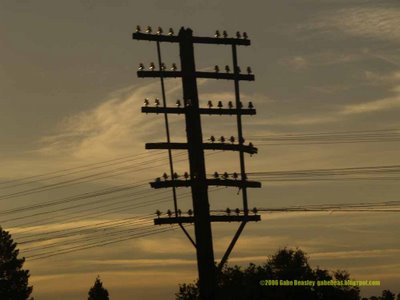 After shooting very heavy, dropping, moving, bumping and using my camera in dangerous environments my digital SLR has developed a problem. I've taken latterly about 10,000
After shooting very heavy, dropping, moving, bumping and using my camera in dangerous environments my digital SLR has developed a problem. I've taken latterly about 10,000pictures in the past four months. Needless to say I have A LOT of work to do! The problem is minor a small line in the images in red. But it is way too bad to ignore. That's just what happens. I tell everybody to be careful about sweat and water in the summer time. It can reek havoc on cameras and electronics especially in very dry or very humid extremes.
I am currently working to see if I can clean my camera myself and fix the problem or if this is a dreaded bad connection that requires deeper work. I still however have wisely kept my old camera as a backup which I can use still to bring good images at good resolutions. I'm surprised about my digital SLR because I've put it through A LOT. Sweat dropping on it and even rain. Rushing around to get pictures and get the right shot. Ware a scarf on your head to keep sweat from dripping on your gear.
No comments:
Post a Comment